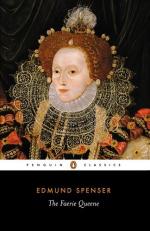XLI
Her joyous presence, and sweet company
In full content he there did long enjoy;
Ne wicked envie, ne vile gealosy,
His deare delights were able to annoy:
Yet swimming in that sea of blissfull
joy, 365
He nought forgot how he whilome had sworne,
In case he could that monstrous beast
destroy,
Unto his Faerie Queene backe to returne;
The which he shortly did, and Una left to mourne.
XLII
Now strike your sailes ye jolly Mariners,
370
For we be come unto a quiet rode,
Where we must land some of our passengers,
And light this wearie vessell of her lode.
Here she a while may make her safe abode,
Till she repaired have her tackles spent,[*]
375
And wants supplide. And then againe
abroad
On the long voyage whereto she is bent:
Well may she speede and fairely finish her intent.
* * * * *
NOTES
LINE 1. LO I THE MAN.... An imitation of the opening lines of Vergil’s Aeneid:—
“Ille ego, qui quondam gracili modulatus
avena
Carmen,...
Gratum opus agricolis, at nunc horrentia
Martis.”
Referring to his Shepheards Calender (1579) Spenser thus gracefully indicates his change from pastoral to epic poetry.
5-9. KNIGHTS AND LADIES. The poet here imitates the opening of Ariosto’s Orlando Furioso.
10. O HOLY VIRGIN CHIEFE OF NINE, refers to Clio, the muse of history. Spenser should have invoked Calliope, the muse of poetry.
14. OF FAERIE KNIGHTS, the the champions of Gloriana, the queen of Faerieland. FAIREST TANAQUILL, a British princess, daughter of Oberon, king of Faerieland. In the allegory she is Queen Elizabeth.
15. THAT MOST NOBLE BRITON PRINCE is Prince Arthur, the perfect knight, who is in love with Gloriana. In the allegory the Earl of Leicester is probably meant, though by one tradition Sir Philip Sidney is identified with Prince Arthur.
19. IMPE OF HIGHEST JOVE, Cupid, the god of love, and son of Jupiter and Venus. He is represented as armed with an ebony bow (l. 23).
25. TRIUMPHANT MART, Mars, the god of war. The spelling is that of the Italians and Chaucer.
28. O GODDESSE HEAVENLY BRIGHT, Queen Elizabeth (aged 56), who was fond of such extravagant flattery, and expected it of all her courtiers.
31. PHOEBUS LAMPE, Apollo, the sun-god.
34. GLORIOUS TYPE OF THINE, the Lady Una, who stands for Truth in the allegory.
35. THE ARGUMENT OF MINE AFFLICTED STILE, the subject of my humble pen. “Afflicted” has the original Latin sense of “cast down.”
36. O DEAREST DRED, O beloved object of reverence; a common salutation of royalty.




